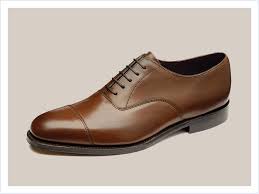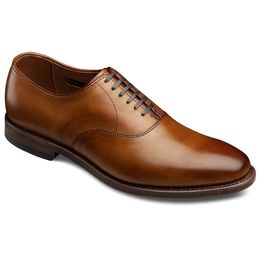Dress Shoe Guide for 'Not-So-Tall' Men

Historically, rules regarding dress shoes - what to wear, when and with what - were not only clear but generally well-adhered to.
Times have changed, however, and many of these traditional rules are being flaunted, bent and ultimately broken.
We felt it was timely and important to review the 'old rules', many of which are still apt, in order to understand each shoe better.
There's a proper way to break the rules, but understanding them in the first place is essential.
To begin with, the less adornment on a shoe generally makes for a more formal shoe, as do lace-ups. Closed lacing is more formal than open lacing (more on this later).
Slip-ons or buckled shoes are more casual. Black shoes are more formal than brown or two-tone shoes.

Oxfords (a.k.a., Balmorals)
The most formal shoe style, and typically the best to wear with a suit, is the oxford or balmoral, sometimes referred to as a balmoral oxford, or bals.
These days if you just say oxford, any good shoe department or store will know what you mean.

The oxford can have a cap toe:

...or a plain toe:

And its most characteristic mark is the closed lacing, which gives the oxford a sleeker and more elegant look.
Closed Lacing vs. Open Lacing
Closed lacing is formed from the sides of the shoe under the vamp and when laced properly will have no opening (i.e. the two sides of leather come together to form a seam).
Open lacing is created when flaps are sewn on top of the vamp, and after lacing there will remain a space between the flaps. Neither is wrong, just different.

The oxford can come in different shapes (made from different lasts) and has a rounded toe. Some oxfords are elongated and can have a pointier toe.
These can be elegant but we do not recommend shoes with too much elongation for shorter men.
We also recommend against wearing a square-toed oxford or slip-on with a suit or dress pants.
Derbys (a.k.a., Bluchers)
Derbys, also known as bluchers, are more casual, have open lacing and can be worn with jeans and chinos.
High quality oxfords of any style typically do not work with more casual pants like jeans and chinos. Derbys are more versatile and some can, in fact, be worn with a suit.
See two options below, which can easily be dressed up or dressed down:


Derbys come in three different styles, plain toe (above right), cap toe, and wing tip. Derbys are called Brogues when the leather placed on them has perforations.
Remarkably, the perforations of highly “brogued” derbys used to be functional! They allowed water to seep in and out during long walks on damp bogs in Scotland and England.
Decoration is what defines the different Derby styles.
Wingtips

Wingtips, which for past generations was the 'dad' shoe and had more of an old-fashioned following, have had a resurgence more recently.
A wingtip is a shoe that has a 'W' shaped design on its toe cap.

Typically wingtips are highly 'brogued'. Broguing makes a shoe less formal (remember the bogs), which has introduced a bit of style confusion.
In recent years men have been wearing brogued wingtips with suits, popularized by the highly influential menswear designer Thom Browne. Now a brogued shoe can even be worn with a suit to semi-formal occasions.
Two variations on the wingtip are the semi-brogue, which also has decorative perforations but usually a straight toe cap or no cap; and long wing brogues where the wingtip wraps around the entire shoe and meets in the back at the heel.

These days a chunky brogued wingtip can be worn nicely with a suit, dress pants and a blazer, or jeans and a jacket.
However, a sleeker more elongated wingtip is generally more appropriate with a suit. Black wingtips can never be worn with a tuxedo.
Patent Leather Oxfords
For formal wear, a sleek non-perforated oxford in regular or black patent leather (or a patent leather tuxedo slipper) are still the only things that are appropriate to wear for the most formal occasions.

Tasseled loafers, plain slip-on loafers, penny loafers or a bit loafer (popularized by Gucci decades ago) can all be worn with dress pants and a jacket for casual or semi casual events.
With a bit of confidence, these can also be worn with a suit, as long as it's in conjunction with an open collared shirt (i.e. no tie).
Monk Strap Shoes
Monk strap shoes have become popular in recent years as an alternative to traditional lace-ups or slip-ons.
These are leather shoes with a flap and a buckle or two, instead of laces, and can sometimes be a tricky shoe to pull off.

We recommend wearing monk strap shoes with wool or linen pants, and occasionally with jeans. Again, the more ambitious can pair them with a suit.
Dress Boots
Dress boots have also become popular in recent years, and while they can be fun, they upend the rule about boots with suits.
We think they work well with a suit on a day with inclement weather, and certainly with more casual looks; but in general, we think they are best kept separate from suiting and more formal wear.

When wearing suits we recommend keeping your shoe to a darker color, black, deep brown and or dark cordovan.

Lighter colors and some gradation in tone should be reserved for more casual wear (i.e. jeans and a blazer).
Key Takeaways
In summary, investing in a good oxford, wingtip and slip-on loafer will ensure you're prepared for all occasions.
It's fine to venture outside the lines a bit, as long as you know what you're doing. We recommend owning fewer shoes, but of the highest quality.
A good shoe, worn appropriately, and well maintained (always use shoe trees!) can last for years.
READ NEXT: Spring and Summer Shoe Guide



